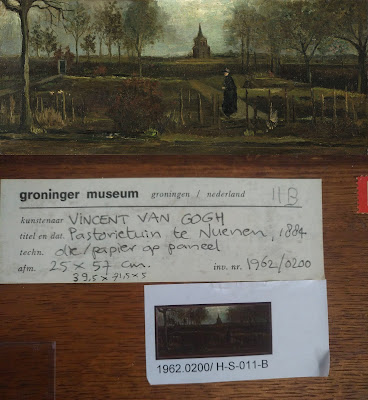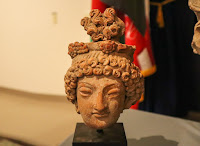In the summer of 2015 thieves entered a five-story building on the Plaza de la Encarnación —an affluent area in the center of Madrid near the Spanish Senate and the Royal Palace. Once inside, the burglars broke into the residence of banker José Capelo Blanco.
Entering his apartment without being seen by the doorman or other residents, the raiders quickly disabled the businessman's alarm system and set about stealing five visceral portraits, made by the Irish-born British figurative painter Francis Bacon. The paintings would later be estimated to be worth €30 million. In addition to the high value fine art, the thieves also accessed the homeowner's safe and stole jewellery and a collection of ancient coins valued at €400,000. Newspapers would later report that the crime was exceedingly professional and left behind few clues.
By the early autumn, an accomplice, with prior convictions for drug trafficking, began making the first of multiple efforts to try to sell the hot Bacons through market contacts in Spain. One of these involved trying to persuade a distant member of his extended family, who worked in the art world, that he could make a lot of money, if he could help find a buyer.
Up until this point, images of the paintings had not been shared publicly, as the artworks were gifted by the artist directly to Capelo Blanco and had therefore never appeared in circulation prior. The fact that images of the Bacons did not appear publically, perhaps emboldened the thieves to make their first mistake.
In February 2016, the first major break in the case came in when an individual queried the Art Loss Register trying to establish if one of Capelo Blanco's portraits had been flagged internationally as stolen. Writing anonymously, the inquirer sent photographs of the painting which could only have been taken by individuals with access to the artworks after the theft in Madrid.
This exchange proved critical to the investigation and the ALR worked with the Spanish National Police turning over the communique which allowed investigators to draw a red circle around their first group of potential suspects.
In early March 2016 the four individuals were taken into custody:
• Ricardo Barbastro Heras, the alleged organiser of the fencing network
• Antonio Losada de la Rosa
• José Losada Manzano
• Rafael Heredia González
All were charged with crimes of concealment of robbery with force.
By May 28, 2016 Spanish news sites reported that agents working with the Central Specialized and Violent Crime Unit (UDEV) had arrested another six individuals in Madrid who were also believed to be connected to the 2015 theft in some way. This included:
• Alfredo Cristian Ferriz González, AKA Cristian Ferriz, who has a long police record, eight of them for robbery with force, three for vehicle theft, one for threats and another for drug traffic.
• Art dealer Cristóbal García
• Agustín González Serrano
• Jorge de las Heras Escámez
• Juan Manuel Marce Gea
• Aquilino Jiménez Bermúdez
With ten suspects named, two more, unnamed, were added to the list, bringing the total number of suspects to twelve.
In July 2017 investigators announced the recovery of three of the five Bacon artworks. By January 2021 Dutch private investigator Arthur Brand tweeted a series of "proof-of-life" images which showed the two portraits which remained missing. One of these photos depicted one of the Bacon creations lying beside a copy of Spanish newspaper El País dated October 6, 2019. Another showed the left bottom corner of the one of the painting's verso, which showed the Irish painter's handwriting and signature.
In various articles Brand indicated that he had received word that underworld buyers were considering the two outstanding stolen paintings, telling journalists that he had been passed the video by an unnamed informant, which seemed to indicate that the two remaining artworks were being shopped by an individual using the name which appeared to be shopped by an individual using the nom de plum, "Jason".
Accompanying the video was a piece of paper which implied perhaps that the remaining two paintings might still be in Spain, even if the thieves had widened their buyer's net internationally. Handwritten on the piece of paper which accompanied the video was the contact's alleged name "Jason" noting it was signed at "Starbucks Madrid," on the date of "2020-5-11."
In touch with the Spanish authorities, Brand had announced the contact on his social media channel hoping the unwelcome publicity would serve to dissuade potential purchasers who might be considering the stolen Bacons. Meanwhile Spanish authorities continued to tighten the screws, arresting two more not publicly named individuals, which brought the total number of persons of interest (publicly announced) to twelve.
Last month, on 29 February 2024 the Historical Heritage Brigade of Spain's National Police arrested two more people in the southern area of Madrid. The pair are believed to be the persons with physical control of the two outstanding artworks.
Aged 53 and 25, one of the arrestees is named as Rubén Sánchez Hernández.
Considered to be the mastermind behind this robbery, he is also believed to have been involved in the Pink Panther-styled robbery of Ángeles Farga jewelry store, on Ortega y Gasset Street in the capital. According to Spanish news sites, Sánchez Hernández has connections to Roberto Anaut's gang, the 'Dragonems' and disciple of Ángel Suárez Flores, who was in charge of another outstanding paintings theft involving 17 paintings stolen from the residence of businesswoman and philanthropist Esther María Koplowitz y Romero de Juseu, the 7th Marchioness of Casa Peñalver in August 2001.
The artist Francis Bacon died on April 28, 1992 at the Ruber clinic in Madrid at 82 years of age. Prior to his death he was reportedly in love with the young Spanish financier to whom gifted the paintings.
For now, the last two paintings remain listed on Interpol's stolen Works of Art database.
 art theft,jewellery
art theft,jewellery
 No comments
No comments

































